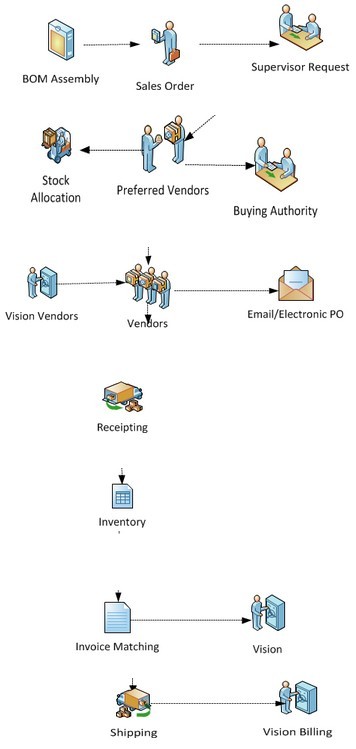Ghost Assets
Ghost assets increase expenses, reduce productivity and exist in almost every company. Here is how to identify them, remove them and prevent them recurring.
Ghost assets increase expenses, reduce productivity and exist in almost every company. Here is how to identify them, remove them and prevent them recurring.
Quickly understand the pro’s and con’s of using Barcode and RFID technology for asset tracking & management. Compare the costs, hardware and applications.
Why lean asset management in manufacturing works back to front and how it cuts out the seven types of waste in the production process.
Why good asset management is key to making renewable energy a cost effective alternative to non-renewables.

Sam was enthusiastic and friendly as she told me about her project to look for a new asset management system. Her company had built the current system in-house, but as they grew they realised they needed something a bit more comprehensive. It sounded like a great project, but being new to asset management software I didn’t see the warning signs.
Fast-forward 9 months and Sam sounded a lot less enthusiastic and I felt the same. Despite all the initial enthusiasm, and a lot of work, we were still no closer to deciding if the project would go ahead. Where did it all go so wrong?
Looking back, we made three simple mistakes that can derail any asset management project before it even gets going:
Sam’s title should have been a red flag – “Project Support”. It was not her fault, but she did not have the experience or authority to drive through a project this big. When a project does not have an internal project sponsor or ‘champion’ with the authority to agree or veto changes, they usually just get passed on to the potential supplier as an additional feature request.
The lack of a clear, well thought through and targeted project specification increases the risk of an overly complex solution that is delivered late and over budget. The worst case scenario is that the project gets bogged down through a lack of direction and multiple layers of complexity. It eventually gets shelved without ever being delivered, but still at a significant cost to the client.
CHECKLIST
✓ Plan for the project sponsor to be actively involved
✓ Ensure the sponsor has the authority to agree the scope and specifications
✓ Establish the budget early on to avoid shocks at a later date
George Harrison’s lyrics to ‘Any Road‘ could have been the theme for this project – “If you don’t know where you’re going, any road will take you there”. Asset management systems can cover anything from purchasing through production and sales orders, as well as depreciation, tracking and maintenance.
Typically, asset management projects will involve finance, operations and IT as a minimum, so the potential for scope creep is a big risk. Sam’s task was to find the best system, except no one really knew what that looked like.
CHECKLIST
✓ Establish a cross functional project team before you start
✓ List your must-haves and nice-to-haves for any potential supplier
✓ Agree scenarios for suppliers to show you rather than a generic demo
When I asked Sam which finance package her company used, she sounded a bit surprised and asked why I needed to know. It had not occurred to her that any asset she managed would need to be loaded from somewhere and its value posted back.
A recent survey by the Access Group estimates that almost half of employees in the UK waste 3 hours a day or more on inefficient systems. A lack of integration can wipe out the savings that your new system is intended to deliver.
CHECKLIST
✓ Map the asset life cycle to see how and where each stage will be recorded
✓ Check what software integration each supplier provides
✓ Record all your interfaces centrally for future upgrades or new software
For more information on getting asset management systems right, have a read of the 10 Steps Guide to Asset Management.

Whether you agree with the Better Together campaign or not, one thing is clear, from an accounting point of view it would certainly be simpler to stay together. Much has been made of big banks such as the Royal Bank of Scotland’s proposed move out of Scotland if there is a yes vote, but the impact for many smaller businesses will be significant as well. Overnight, businesses across the country could become multi-nationals just by virtue of having a branch in Scotland.
Victoria Stanley, Senior Consultant at FMIS, talks about 3 key issues that will need to be considered by fixed asset accountants and management teams in the event of an independent Scotland.
Bank of England governor Mark Carney and leading figures in Downing Street have made it clear that a straightforward currency union is unlikely. A new Scottish currency could create the need for valuing assets in multiple currencies. For firms using simple Excel based registers or even some off the shelf products, this would be a big challenge.
Having business units in different countries can mean the creation of multiple companies within a group. In addition to the initial complexities of restructuring a business, the changes will need to be reflected in a company’s asset register as well. Simple fixed asset actions like moving an item from one branch to another will now require an inter-company transfer and all the assets will need allocating to one of the companies. Again this is going to get complex when working with a spreadsheet or basic asset management system.
The SNP has certainly positioned itself as a left of centre party, and as the Guardian points out, a new government would need to fund the creation of new systems and structures, all of which seems to point to increasing not decreasing taxes. Different tax rules mean that assets will need to be treated differently depending on where they are.
At the time of writing, the outcome of the vote is too close to call and any changes may take months or years to come into full effect. The reality is, however, that an independent Scotland would mean significant changes to how businesses record their fixed assets and the nice simple spreadsheet is unlikely to be an option.
FMIS asset management software is multi-company, multi-currency and flexible enough to handle international tax reporting requirements. For more information on FMIS Fixed Assets and other products, please see our product pages or contact one of the team directly at sales@fmis.co.uk or on +44 (0) 1227 773003.

Exponent is an international engineering and scientific consulting company with 25 offices worldwide. Their engineers and scientists have worked on many high profile incidents.
“Exponent has been using Vision since 2007. We found that though the majority of the company was not purchasing intense, there were several groups that were, and each had their own process. It was time to unify and standardise the process. In FMIS, Exponent found a system that provided the flexibility we needed to accommodate our approval matrixes while still seamlessly interacting and taking advantage of the capabilities of Vision.”
Because Exponent staff are involved in a diverse range of projects, they needed a comprehensive but flexible purchase order processing (POP) software system. Their requirements included access to an approval process that allows their requisition orders to be signed off by the appropriate staff in line with their individual approval limits and project association, before the purchase orders are automatically generated.
Because Exponent already used Deltek Vision, they needed purchase order processing software that linked directly with their existing system. All FMIS products including Purchase Order Processing are designed to integrate directly with the Vision software. FMIS Purchase Order Processing will automatically match purchase orders against the relevant invoice, with any amends flagged for approval before posting to the general ledger in Vision.
When considering suppliers, Exponent wanted to be confident that their chosen provider had the experience and stability to provide the level of service required over the long term. FMIS software is used in over 40 countries worldwide and has been leading the industry for over 30 years, thus Exponent was able to call industry leading clients, such as Transammonia as a reference.
For more information on FMIS Purchase Order Processing and other products, please see our product pages or contact one of the team directly at sales@fmis.co.uk or on +44 (0) 1227 773003.

The AA was recently confirmed as the UK’s most trusted brand*, so it’s great that they trust FMIS Leasing software to forecast, calculate and track the monthly leases for their operational fleet. FMIS was commissioned to reduce the total time it took to prepare the month end accounts for all of the fleet adjustments, additions and periodic forecasts. FMIS was able to reduce the time required for the whole process from several days to a matter of hours.
“The AA is a diverse business with several different types of operational vehicles and a complex VAT structure. We chose FMIS as our partner as they demonstrated how their system was flexible enough to meet our requirements. The FMIS support team are working closely with us to continually improve and develop the Finance Lease Software that meets our on-going requirements.”
The AA has a wide variety of lease types that the selected system had to be flexible enough to handle such as:
Tailored dashboards allow all the key stakeholders from Operations through Finance to view the information they need, when they need it and in a format that is useful to them.
As the AA’s requirements have developed, FMIS Leasing software has been flexible enough to grow with them. FMIS provides ongoing support for all their clients including regular product enhancements to ensure FMIS Leasing remains ahead of the game and compliant with all accounting standards, such as IAS17.
For more information on FMIS Leasing and other products, please see our product pages or contact one of the team directly at sales@fmis.co.uk or on +44 (0) 1227 773003.
* Source: Survey of more than 3,000 people in the UK aged 18-74 between 4 January and 7 February 2014 by Rainey Kelley Campbell Roalfe / Y&R’s BrandAsset Valuator (BAV).
Learn about the risks of using spreadsheets to manage fixed assets in this insightful article from FMIS. Discover the five reasons why relying on spreadsheets can be dangerous, and find out how you can improve your asset management processes to ensure accuracy and reliability.

The customer, a comprehensive professional services firm providing design solutions to private and public sector clients, required an efficient sales order processing system integrating with Deltek Vision. Key requirements included: billing interface with Vision, accounts payable interface via invoice matching, strong control over product item master records, including complex bill of material assembly.

Sales Order Processing flow chart
The sales order can be made up of many combinations of assemblies, items and services. As a user constructs the sales order the system provides real time control over margins and build specifications. The system allowed an easy set up of all required parts and a straight forward authorisation trail.
The purchase order will be automatically routed to the preferred vendor for the associated items within the bill of assembly. Vendor selection can be overridden on the sales order if required. The user can also select the item to come from stock, selecting a specific batch quantity or serial number to be added to the packing list. Any final purchase orders will be emailed to the vendor once any authorisation has been completed.
Vendors receive the purchase order by mail or by email. A system alert manager monitors the progress of the purchase against the required delivery dates. Purchase order amendments can be raised at any time. Utility bills and other contracted costs can also be entered as purchase contracts.
Each category of product has its own set of attributes to be used when recording the eventual receipt of the goods or service. Any serialised item can have make, model, year of manufacture, serial number or any other items captured by electronic entry, manual entry or through the punch-out service.
Any IT equipment is logged into the physical asset register passing on all of the prior information collated to date. The Equipment system allows for asset tracking and automatic reconciliation with the Fixed Asset register.
Vendor invoices can now be easily matched (two, three or four-way) against the system. The batch of vendor invoices are automatically generated into the Vision Accounts Payable system. Any variances, subject to route and category limits, will automate the production of a new purchase order change request.
All part/full shipments will generate a billing entry in Vision with the correct sales order references, quantity and values. Shipping documents can be formatted and templated by the system.
FMIS Ltd
167b John Wilson Business Park
Whitstable
Kent
CT5 3RA
United Kingdom
Phone:+44 (0) 1227 773003
Fax:+44 (0) 1227 773005
Sales:sales@fmis.co.uk
Support:support@fmis.co.uk
| Cookie | Duration | Description |
|---|---|---|
| cookielawinfo-checkbox-advertisement | 1 year | Set by the GDPR Cookie Consent plugin, this cookie is used to record the user consent for the cookies in the "Advertisement" category . |
| cookielawinfo-checkbox-analytics | 11 months | This cookie is set by GDPR Cookie Consent plugin. The cookie is used to store the user consent for the cookies in the category "Analytics". |
| cookielawinfo-checkbox-functional | 11 months | The cookie is set by GDPR cookie consent to record the user consent for the cookies in the category "Functional". |
| cookielawinfo-checkbox-necessary | 11 months | This cookie is set by GDPR Cookie Consent plugin. The cookies is used to store the user consent for the cookies in the category "Necessary". |
| cookielawinfo-checkbox-others | 11 months | This cookie is set by GDPR Cookie Consent plugin. The cookie is used to store the user consent for the cookies in the category "Other. |
| cookielawinfo-checkbox-performance | 11 months | This cookie is set by GDPR Cookie Consent plugin. The cookie is used to store the user consent for the cookies in the category "Performance". |
| CookieLawInfoConsent | 1 year | Records the default button state of the corresponding category & the status of CCPA. It works only in coordination with the primary cookie. |
| PHPSESSID | session | This cookie is native to PHP applications. The cookie is used to store and identify a users' unique session ID for the purpose of managing user session on the website. The cookie is a session cookies and is deleted when all the browser windows are closed. |
| viewed_cookie_policy | 11 months | The cookie is set by the GDPR Cookie Consent plugin and is used to store whether or not user has consented to the use of cookies. It does not store any personal data. |
| Cookie | Duration | Description |
|---|---|---|
| CONSENT | 2 years | YouTube sets this cookie via embedded youtube-videos and registers anonymous statistical data. |
| _ga | 2 years | The _ga cookie, installed by Google Analytics, calculates visitor, session and campaign data and also keeps track of site usage for the site's analytics report. The cookie stores information anonymously and assigns a randomly generated number to recognize unique visitors. |
| _gat_UA-48954022-1 | 1 minute | A variation of the _gat cookie set by Google Analytics and Google Tag Manager to allow website owners to track visitor behaviour and measure site performance. The pattern element in the name contains the unique identity number of the account or website it relates to. |
| _gid | 1 day | Installed by Google Analytics, _gid cookie stores information on how visitors use a website, while also creating an analytics report of the website's performance. Some of the data that are collected include the number of visitors, their source, and the pages they visit anonymously. |
| Cookie | Duration | Description |
|---|---|---|
| VISITOR_INFO1_LIVE | 5 months 27 days | A cookie set by YouTube to measure bandwidth that determines whether the user gets the new or old player interface. |
| YSC | session | YSC cookie is set by Youtube and is used to track the views of embedded videos on Youtube pages. |
| yt-remote-connected-devices | never | YouTube sets this cookie to store the video preferences of the user using embedded YouTube video. |
| yt-remote-device-id | never | YouTube sets this cookie to store the video preferences of the user using embedded YouTube video. |
